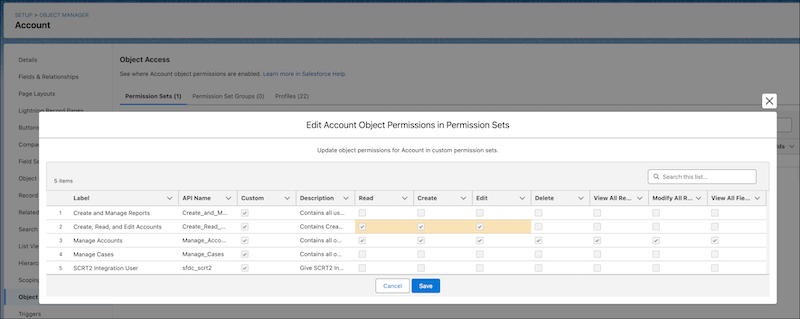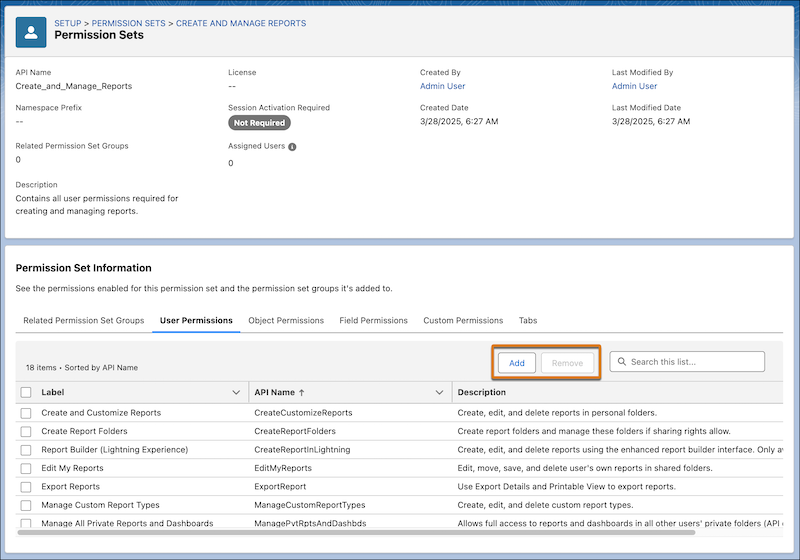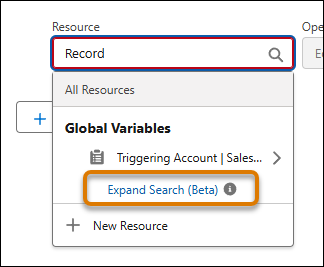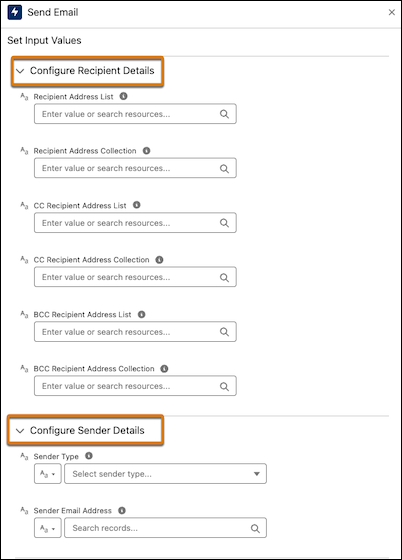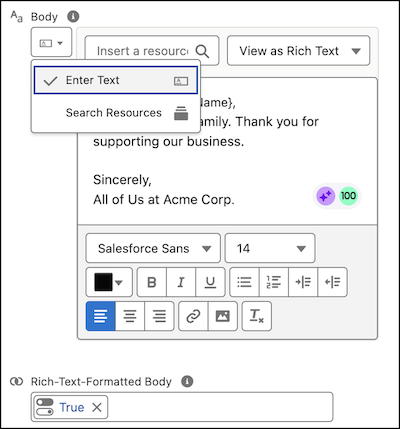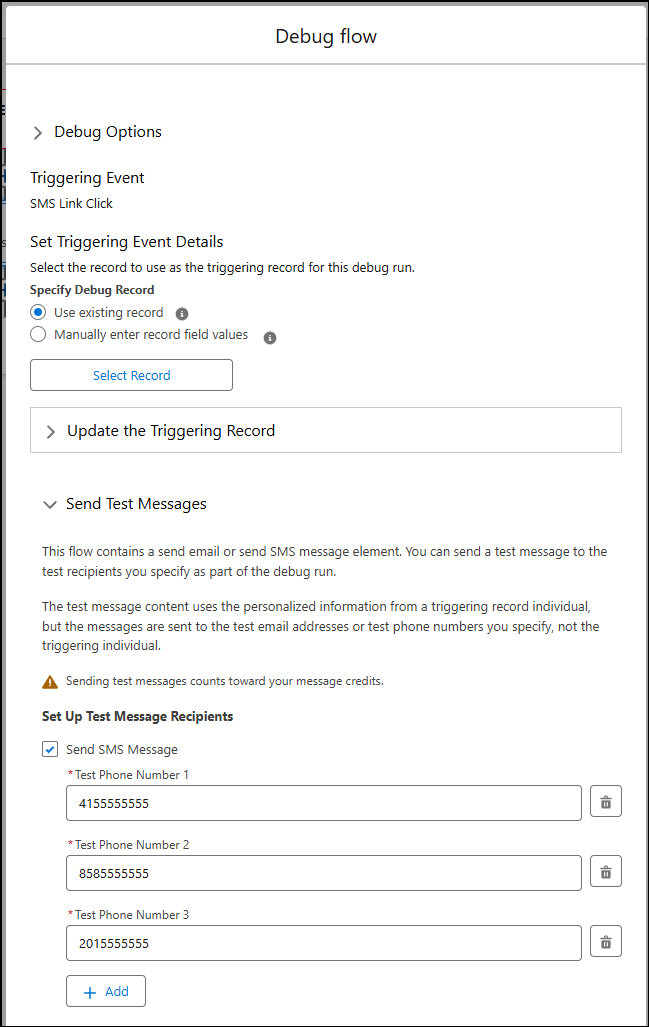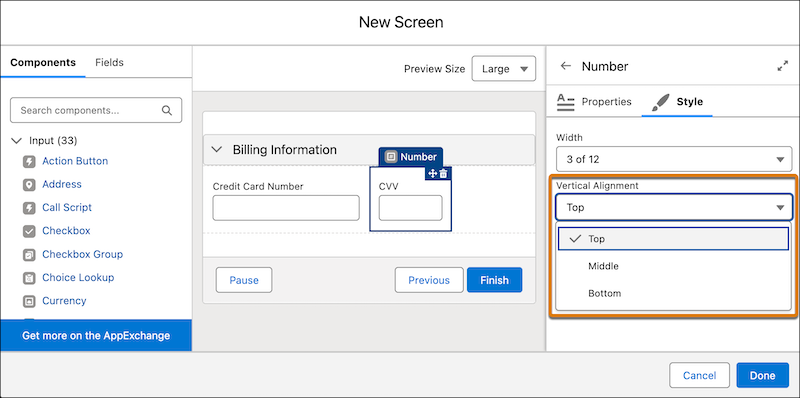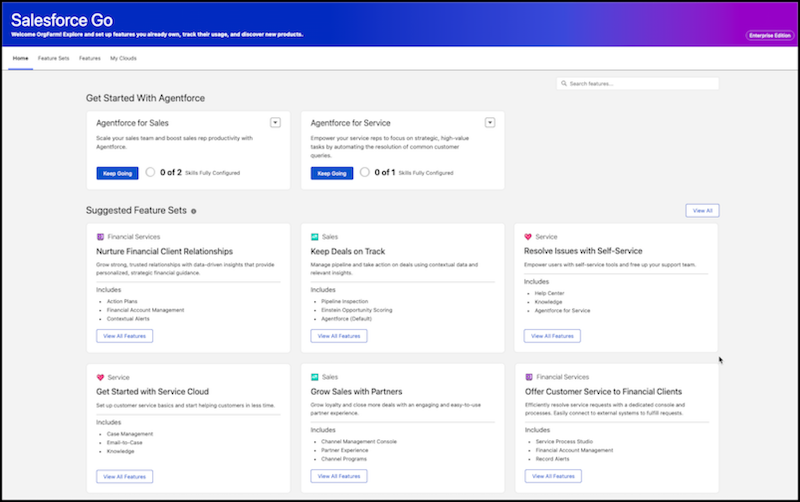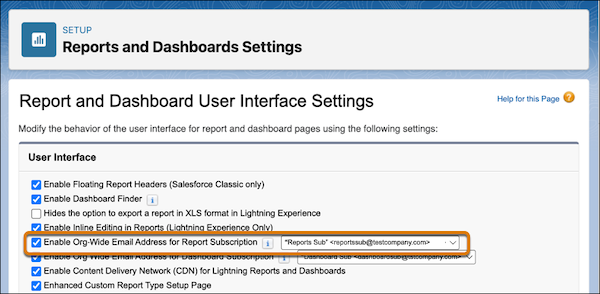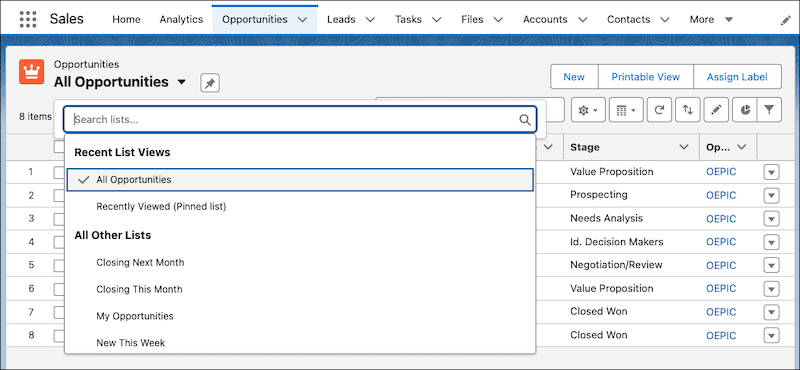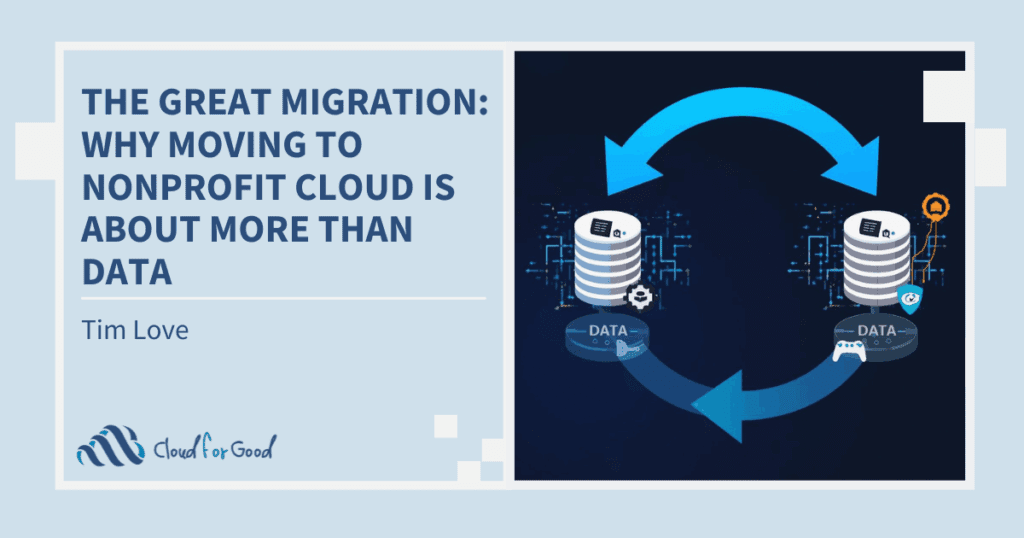Salesforce’s Summer ‘25 release is packed with updates designed to improve your user experience, simplify managing your Salesforce org, and create even more value with your organization’s Salesforce investment. We’ve done the heavy lifting and combed through the Summer ‘25 release notes to bring you the most important highlights in Security & Permissions enhancements, automation and screen flow updates, and more. Read on to learn more.
Security and Permissions Updates
Salesforce just made managing Permission Sets and Profiles a whole lot easier with the help of users’ ideas from the IdeaExchange platform. This update is all about giving Admins more control and flexibility with less hassle.
Update Object Permissions for All Custom Permission Sets or Profiles in One Step
Ever wish you could update object permissions across all custom permission sets and profiles without clicking into each one? With this new feature, now you can. To check out this update, head to Object Manager, select an object, and open Object Access. From there, you can review, update, or remove object-level permissions all in one place. This is a huge time saver for Admins managing complex orgs with multiple Permission Sets or Profiles.
Edit Permissions Faster in the Permission Set Summary
Users no longer need to jump between multiple Setup pages just to make simple permission changes. With this update, you can now edit user, object, field, and custom permissions directly from the Permissions Set Summary view. From Setup, select a Permission Set, and click View Summary. From there, you can make your updates quickly and in one place; saving you time and clicks.
Manage Included Permission Sets in the Permission Set Group Summary
Admins can now add or remove Permission Sets within a Permission Set Group directly from the Summary View. Previously, this screen was read-only, but with the latest update, you can manage included Permission Sets without navigating elsewhere. It’s a small change that makes a substantial difference in your workflow.
View and Manage a User’s Permission Sets, Groups, and Queues More Easily
Salesforce just made user access management more efficient with the enhanced User Access Summary. Through this update, you can now view and manage a user’s Permission Sets, Permission Set Groups, and Queues directly from their user record. To view the enhanced User Access Summary, navigate to Setup, select a User, and click View Summary to add or remove access all in one place.
Automation Updates
Find More Resources with Expanded Search (Beta)
Salesforce is reintroducing Expanded Search in Flow Builder in response to customer feedback. You can now expand your search to include more resource types, such as fields from records, related actions, components, and outputs, helping you work faster and more efficiently. This update is currently in Beta.
Test Flows for Error Handling
Things don’t always go as planned, and now your flow tests can reflect that. With the new Has Error operator, you can simulate failure scenarios and understand how your flows handle errors. Previously, flow tests only supported positive assertions for successful outcomes. Now, you can add negative assertions to test what happens when things go wrong. This new feature is available in flow tests for record-triggered and Data Cloud-triggered flows, and can be used to test error handling for Create Records, Update Records, Delete Records, and Action elements.
Manage Elements Faster in Auto-Layout Mode for All Flow Types
Flow Builder just got a usability boost. The updated Auto-layout canvas now includes redesigned element cards that make building and managing flows effortless. These enhanced element cards offer a larger selection area, one-click access to the configuration panel, quick access to element actions, and a cleaner, more streamlined interface. The new element cards are available for all flow types.
Find Send Email Action Inputs Easier with Organized Inputs
Thanks to newly organized input sections, configuring email automation in flow and setting up Send Email action inputs is now easier and more intuitive. Inputs are grouped into clear categories, such as Recipients, Send, and Email Content, allowing you to quickly find and update the fields you need.
Compose Your Email Content or Select Templates Within the Send Email Action
Salesforce has made it even simpler to compose and send branded, tailored emails directly from your flows. With this latest release, you can now write and format your email content directly within the Send Email action without the hassle of creating a separate text template resource. You can also select pre-existing email templates by name rather than by template ID.
Test Email and SMS Sends with Test Messages
Ever struggled with testing Email or SMS Sends in Salesforce? Now you can easily test your Send Email or Send SMS actions during a debug run. Simply specify the email addresses or phone numbers to use for testing and the flow will attempt to send the messages. This makes it easy to verify your messages before going live.
Screen Flow Updates
Get More Control Over Component and Field Layout in Screen Flows
You can now adjust the width and vertical alignment of screen components and record fields with new customization capabilities. This update gives you more control over your screen flow layouts, and the additional flexibility allows you to create more balanced and intentional designs that better suit your needs.
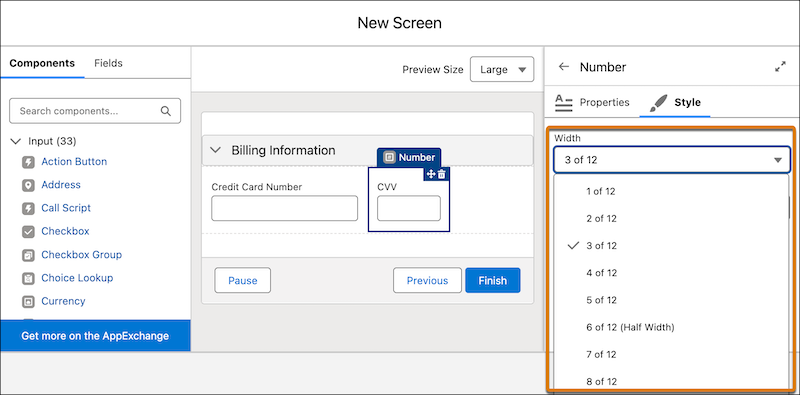
See How Your Screen Looks in Real Time on Different Screen Sizes
With the new Preview Size feature, you can instantly see how your screen will appear on large, medium, or small device screens directly in Flow Builder. Spot and resolve layout issues during the design process to ensure your screens look polished and perform well on any device.
Display Choices in Tiles with the Visual Picker Component in Screen Flows
Make screen flows more intuitive and visually engaging with the Visual Picker component. Instead of dropdowns or long picklists, users can present choices as clickable tiles that use icons and text. This clear, visually appealing layout helps users quickly identify and select an option, improving the overall user experience.
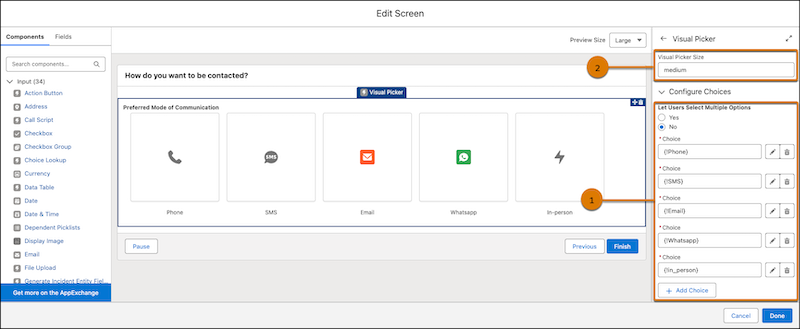
General Enhancements
Simplify Feature Discovery and Setup with Salesforce Go
Salesforce has introduced Salesforce Go, a new tool that helps you discover, configure, and manage features available in your org. Think of it as your guided setup hub—perfect for exploring new or unused capabilities.
With Salesforce Go, you can:
- Assign user permissions
- Complete prerequisites and configuration steps
- Monitor feature usage
To access Salesforce Go, you’ll need the View Setup and Configuration permission. You’ll also need the Customize Application permission to turn on features. Once those are assigned, you can launch Salesforce Go from the gear menu.
Choose Which Dashboard Widgets to Refresh (Generally Available)
No need to refresh an entire dashboard just to see updated data in one widget. With this new enhancement, you can now refresh individual dashboard widgets as needed.
Designate One Email Address to Send Report Subscription Notifications (Generally Available)
You can now send report subscription notifications from a single organization-wide email address, simplifying and securing your email communications. Previously, emails came from the address of the user who created the report subscription. Now, you can centralize these notifications for consistency and clarity. To set up this new feature, navigate to Reports and Dashboards Settings.
Enhance Accessibility with the Improved List Views Dropdown Menu
The List Views dropdown menu for all objects now uses Lightning Web Components (LWC), improving accessibility and creating a more consistent user experience. While the way users interact with list views remains unchanged, the updated dropdown brings a smoother navigation experience. Previously, this feature was available only for list views rendered with LWC, but now it is available across all list views.
Easily Remove Relationships Before Deleting a Custom Object
Managing custom objects just got easier. When attempting to delete a custom object that has relationships with other objects, you’ll now see a more detailed page outlining those relationships. This page includes:
- A table listing related objects
- The object’s API name and field API name
- Hyperlinks to the object API name for easy navigation and removal of the relationship
Please note that with any new enhancement, it’s best practice to test these new features in a sandbox environment first. Each Salesforce release is made possible by ideas submitted by users through Salesforce IdeaExchange, and you and your organization can make a difference by engaging in IdeaExchange!
If you have questions about the updates and features of the Summer ‘25 Release, or would like to learn more about how your organization can benefit from these enhancements, please get in touch with us.
You Might Also Enjoy:
Release Blog: Salesforce Summer ‘24 Release: What You Need to Know
Release Blog: Salesforce Spring ‘24 Release: What You Need to Know
Release Blog: Salesforce Winter ’24 Release: What You Need to Know


